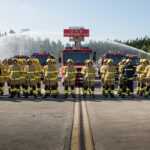DFB Museum Curator Paul Hand tells Adam Hyland about his restoration of an 1884 Escape Ladder.
“This project started for me in spring of 2019, when a man named Martin Thompson called me and said he had an old escape ladder from the late-1800s, and was looking to find a better home for it,” DFB Museum Curator Paul Hand tells me as we sit in the museum at the OBI poring over photographs of the ladder in various states of disrepair.
“He was a collector of old fire engines and had about 25 of them at his home in Athy, but he was downsizing his collection, so it was a case of going out to see it and deciding, based on the amount of damage, whether it was worth taking it on and bringing it back to its former glory.”
As the photos show, a lot of work needed to be done to the One-Wheel Escape Ladder used as far back as 1884, which was extensively damaged and “in need of a lot of TLC” as Paul says. “As you can see, it is a fairly big piece of kit, going beyond 100 foot and weighing a couple of tonne,” he points out, “and I needed to gauge whether it was fixable, but when I saw it, I knew I wanted to take it on.
“It had originally come from Newbridge House in north County Dublin, but would have been based at one of the police boxes around the city. You would phone the police box and tell them you needed the ladder, which would then be brought to a building fire and used to rescue people from sometimes great heights. Ladders like this would have been used up until the time when the fire brigade started bringing their own turntable ladders designed by former CFO Purcell to fires, so there is quite a lot of history and a lot of stories attached to it. So, it needed a good home.”
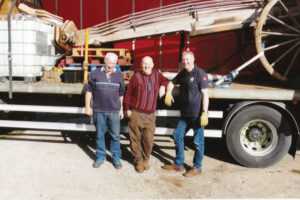
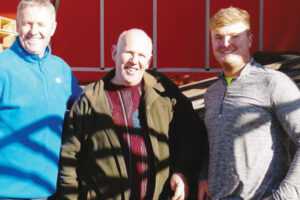
RECOVERY
The first task at hand was to get the ladder loaded up and brought from Athy to Paul’s shed. “The staff and officers at the OBI gave us the use of a truck – so a big thank you to them – and with the help of FF/P Richie Hunter and his son Conor, who both drive forklift trucks, as well as original owner Martin Thompson, we were able to load it on to the truck and bring it to my garden to start the repair work,” Paul tells me.
That was just the beginning of what would be a six-month labour of love, with Paul taking a methodical, step by step approach to the ladder’s restoration, with detailed photographs taken at every stage to illustrate what needed to be done next, and to follow the progress of the project.
“When I got it home, the first thing I had to do was soak the ladder in water for two weeks, just to get it moist again,” Paul says, “because it had been stored for years in a shed and was in a bad state, so I had to keep it wet to expand the wood and make it less brittle.
“It also needed to be washed with cold water to get rid of the red lead paint that covered it, then it had to be scraped clean. While every piece of the ladder had been kept, all of the parts needed to be restored. A lot of them had seized – the pulleys, the uprights, the extension parts – so it had to be stripped right back down into three sections and worked on bit by bit.
“The footplate on one of the sections had also seen some damage because a wire broke on it, one of the pins collapsed and the footplate had slipped, causing a fair amount of damage, but it was repairable. All told, I did about 80% of the repairs.”
Paul got valuable help with the parts he couldn’t repair himself from retired DFB member and carpentry expert Jack O’Rourke. “Jack was very helpful and did some great work,” Paul tells me. “Between us we had to decide whether the wheels needed to be replaced, if we needed to get a wheelwright in, or if we could do them ourselves, and he said he would be able to do it, and did a great job. He stepped in to do the repairs on the wheels and footplates, because you do need a specialist for that kind of work, and he also went out and sourced the timber that was needed. There was some rot in the wheels that he did a great job replacing.”
Paul also received a lot of help from local stores when it came to sourcing parts. “I went to a few places who said they didn’t supply them, but I was lucky enough to go to a company in Ashbourne called HLS, and explained what I was doing and what I needed,” he tells me. “They had the nuts and bolts and screws, and a man called Willie Tuite was very helpful. Whatever I needed, he got for me, and if he couldn’t get it, he told me where I could. I also got a lot of help from TJ O’Mahony’s, and must thank both of them.
“It was the same with the paint I needed. I went to a place called McCarthy’s and explained that I was looking for a specific red paint, and they told me to come back in a week. When I went back, they handed over a tin of paint the size of a mug, so I said that I needed gallons of it, and explained what I was planning to do with it. In fairness, they got it for me within a week.”
With the ladder constructed in 1884, it was not surprising that not all of the parts would be easily available. “There were some parts that I couldn’t get anywhere, so I had to make them myself, and this was the same for some of the tools I needed to restore some parts,” Paul says. “A lot of parts were frozen in time, and to take brass caps off them, for example, I had to make the tools to take them off and get them back in working order.”
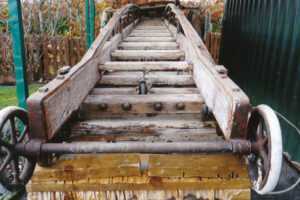
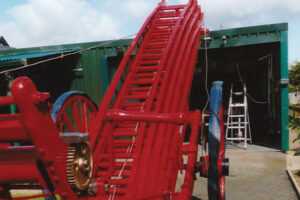

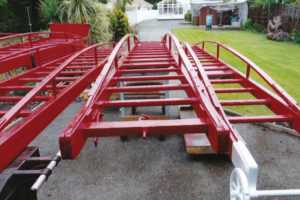
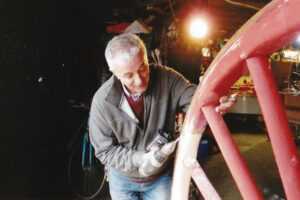
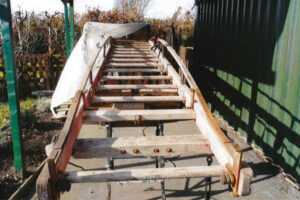
REPAIR
While repairs and replacements were underway, the frame needed to be constantly washed and wetted to restore the timber, then repeatedly treated with woodworm killer, but after three months the ladder had been stripped down into three sections.
“The ladder had to be taken off the gantry to be cleaned, and with that you had to prise it apart. There was a huge amount of metal parts attached to the framework, all of which had to be removed and cleaned thoroughly,” Paul tells me. “The runners were also frozen in time, one was snapped and needed to be welded, and there was a lot of damage throughout, but Jack did some great salvage work on it.
“I also got some great help from the crews from No.4 and No.6 when I needed assistance in raising and lowering the ladder,” he adds. “They came out whenever I needed them and am grateful to them for that.
“It’s not hard work if you use your head in your approach. I took it day by day, step by step, thinking if I could clean this brass today that’s good, if I can unfreeze these parts, grand, everything needed to be taken apart and restored to be put back on, but a lot of it had seized. I took photos as I went along so that I could see exactly what stage I was it with it, and what I needed to start on next.
“It was six months of work, but I looked at it as ‘work of sorts’. If I needed something like a trolley or a hop-up, I made it. Even with all the parts that needed to be restored it never get frustrating, I enjoyed working on it to get every piece and part right, and if another project like it came up tomorrow, I would do it again.
“When it was all restored, I painted the whole thing and it came out looking great. Overall, it probably took six months to get it back to its proper state, but all along I could see what it was going to be like in the end. I had a clear picture in my head, and that kept me going.”
IMPORTANCE
Paul says that he was lucky that the officers and staff at the OBI showed interest in the project from very early on, with discussions ongoing about where the ladder can be housed. “They were saying this is something that needs to be shown, needs to be in display,” Paul says, “and from almost day one they said they wanted to see it come back to the DFB.
“The officers could see what it was and that if the restoration was done right, what it could be, that it was something they wanted to have, but it had to be done right. There was no point in making a mess of it. But they were very impressed with it.”
For now, the ladder remains housed at Paul’s shed, but with a plaque currently being made to detail the ladder’s history, there is talk of possibly housing it in a bigger DFBA museum some time in the future, where it would be an eye-catching and important piece of historical equipment.
“It was a great piece of equipment for its day, but they were nearly all scrapped, so to find one like this is like winning the lotto,” Paul tells me. “There can’t be that many still in existence, maybe one or two in a museum somewhere, but to get hold of one this size is a real find, and to be able to restore it to its former glory was an honour.”
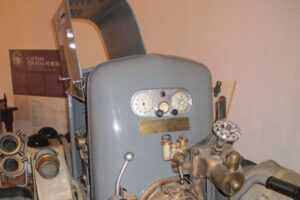
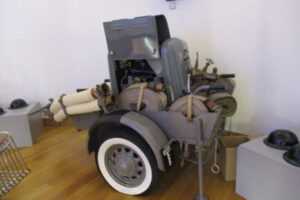
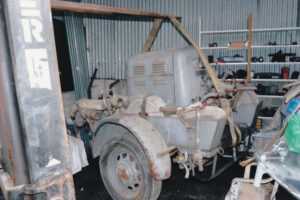

TRAILER PUMPS
Before talking about the ladder restoration project, Paul showed me another piece of historical equipment that he painstakingly restored and which is currently housed in the church building at the OBI.
The Trailer Pump built by Sigmund Pumps Ltd, and which has been loaned to DFB by collector Noel Cassalls in Kildare, was used during the Emergency in Ireland between 1939 and 1945 is possibly one of only two left intact, and as Paul says, “would hold pride of place in any museum”. Restored in 2016, it was brought to the OBI in 2017, but Paul says he hopes to find a good home for it.
“Trailer Pumps like this were common sights on the streets of Dublin and around the country, but of around 5,000 that were made, almost none have survived. It would have been housed in one of the fire stations around the city and manned by the Auxiliary Fire Service who would bring it to a fire where the DFB would take over, but often they would handle the fire themselves. They would have been kept very busy while in operation.
“They were taken out of operation after the Emergency because they weren’t needed any more and almost all of them were scrapped because the materials were needed elsewhere.”
This particular piece of equipment – number 4,206 of 5,000 – came with its hoses, branch pipes and helmets, as well as a very basic toolkit, and Paul restored every part and piece.
As with the ladder, the trailer was in a state of disrepair and took around six months to restore.
“It needed a lot of TLC,” Paul tells me. “It needed a lot of cleaning, as did all of the brass and the other equipment, and the tow bar had been badly damaged, so I stripped it right down and got to work on it before piecing it back together.
“The one thing I didn’t do in the restoration was spray it. The grey colour is because it needed to not be visible from the air at night. It had a single light to operate it in the dark to minimise its visibility.”
Thanks to Paul’s work, all of these parts and elements are easily identifiable and can be admired, and what was once ready for the scrapheap has been transformed into a working trailer pump that holds a lot of history, not just for the DFB, but for the city and country.
“I’m pleased that it turned out very well,” Paul tells me. “It really is an important piece of history.”



